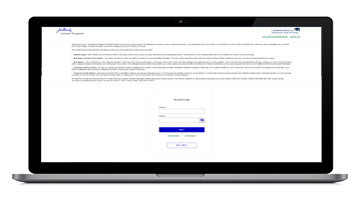Macro meets markets: 5 investable themes to watch
The intersection between the macro backdrop and the market setting investors must navigate has perhaps never been more apparent than it is today. The five themes discussed below highlight this critical intersection.

Tariffs and trade. Recession risks. Geopolitics. In today’s environment, it’s becoming increasingly difficult to not view investment strategies and allocations at least partly through a macroeconomic lens. With that in mind, here are five of our latest high-conviction global macro themes and some potential implications for multi-asset investor portfolios.
1 Monetary policy uncertainty is likely to remain high
In recent years, we’ve observed extreme levels of uncertainty around global monetary policy, as reflected in sharp and frequent swings in the futures market pricing of central bank interest rate cuts. Barring unforeseen circumstances, we anticipate that this trend will likely persist in the months and years to come.
Why the uncertainty? Heightened short-term volatility of two key economic variables—growth and inflation—has been prompting global central bankers to be more data dependent rather than forward looking, driving a more reactive policy function and leading to lower market confidence in the monetary policy path that lies ahead. In addition, severe supply-side constraints since the COVID-19 pandemic have been exacerbating the near-term volatility of growth and inflation readings and the push-and-pull dynamic between the two.
As of this writing, we believe that global growth risks are tilted to the downside, while global inflation risks are clearly skewed to the upside in the wake of the recent U.S. tariff announcements. The U.S. Federal Reserve (Fed) and other world central banks may have to make tough policy decisions regarding whether to prioritize economic growth or inflation, especially as today’s supply-driven inflation backdrop might require very different policy responses than the more demand-driven inflation of previous years.
Multi-asset portfolio implications: Over the past five years, while equity market volatility has fluctuated quite a bit, bond market volatility has remained consistently pronounced. Looking ahead, we expect ongoing monetary policy uncertainty to sustain relatively high bond market volatility, which could act as a headwind to the traditional diversification benefits of government bonds within a multi-asset investor portfolio, particularly on the front end of the yield curve.
Bond market volatility has been higher than equity market volatility in recent years
2 Central bankers may be hesitant to cut rates too deep
That’s largely due to global inflation and the price-level shocks to which it has subjected Main Street consumers: Over the past five years, prices for many core goods and services have surged by more than 30%. Given inflation’s stickiness and potential to accelerate in the period ahead, the Fed and other world central banks may be reluctant to ease monetary policy too aggressively. While some countries’ economies may experience bigger spikes in inflation than others, structural upward inflationary pressures appear to be growing worldwide in today’s macro landscape.
For example, the upcoming U.S. tariff rollout and related factors caused us to ratchet up our U.S. CPI estimates for 2025, 2026, and 2027. On interest rates, over a year ago, we raised our projections for neutral-rate targets (and, recently, further upped our terminal-rate forecasts) in bellwether developed economies such as the United States, Canada, the eurozone, the United Kingdom, and Japan. Along with rising inflation expectations, long-term secular themes such as deglobalization, demographics, and artificial intelligence support our outlook for higher global rates.
That being said, some central banks may have the flexibility to provide further (perhaps even ultra-accommodative) monetary policy easing if necessary; for instance, rate cuts and other measures in the event of a liquidity crisis like we had in 2008, but their bar to do so may be higher than in recent history.
Multi-asset portfolio implications: Global bond yields may continue to be a source of healthy income for many investors, but don’t count on the same amount of price appreciation seen in other monetary policy easing cycles. Moreover, we don’t envision most global central banks (including the Bank of Japan) adopting or returning to zero/negative interest rate policy stances anytime soon.
Price-level inflation shocks: increases in CPI categories since 2020
3 Global central banks may no longer move in unison
Given the tug-of-war tension between economic growth and inflation, and the complications it often creates for monetary policy, we anticipate global central bankers diverging in their policy approaches as they navigate varying domestic conditions in their respective economies. This would mark a sea change from the past several years, when the world’s major central banks tended to move more or less in tandem: Most were slashing rates in 2020, hiking in 2022, and then cutting again in 2024.
In fact, the monetary policy divergence theme has already been in motion for a few months: The Bank of Canada (BoC) and the European Central Bank (ECB) have continued to reduce their benchmark interest rates toward neutral, while the Fed has stayed on hold through the first four months of this year. We expect the Fed to reach neutral by early 2026 and the ECB by mid-2025, whereas the BoC may well go below neutral later this year. The Bank of Japan’s current rate-hiking cycle makes it an outlier among developed-market central banks.
The uneven and nonlinear global impacts of U.S. tariffs further contribute to regional monetary policy discrepancies, as many countries now begin to decouple along trade lines as well. From our perspective, 2025 is shaping up as a year of below-trend yet still positive global growth, but should more worrisome economic deterioration occur, central banks might once again be apt to ease policy synchronously.
Multi-asset portfolio implications: Regional divergences in global central banks’ monetary policy approaches may translate to corresponding adjustments in interest rate differentials among countries. Multi-asset investors should be on the lookout for relative-value opportunities in the global rates and currency spaces while being aware of currency hedging strategies (such as forward contracts) that can help mitigate the risk of changing currency values.
Developed-market central bank policy rates may diverge going forward
4 Global fiscal deficits are mounting and here to stay
In our 2025 macroeconomic outlook, we outlined our argument for why global bond yields may rise in 2025. More than three months later, we expect yields to stay higher for longer due to a combination of tight bond market supply, insufficient buyer demand to match, and (as described above) global central banks’ potential reticence to engage in deep monetary policy easing cycles going forward. As a result, the interest expenses paid by governments to service their debt burdens are likely to remain elevated as well.
In the United States, it’s hard to envision a scenario in which government deficits and debt levels shrink substantially, especially in the midst of slowing domestic growth and potential federal tax cuts (both of which could weigh on tax revenues collected). But what’s particularly noteworthy is that fiscal expansion is no longer just a U.S. story, but rather a global one. Indeed, many of the world’s other largest economies are now undertaking or seriously considering such fiscal policies of their own.
For example, after years of fiscal austerity, Germany’s government recently passed a massive fiscal spending package, and throughout the broader eurozone region, we expect defense spending to climb given the global geopolitical climate. Meanwhile, China seems prepared to deliver additional fiscal stimulus to bolster its economy in the face of a weaker global trade impulse. Japan’s fiscal policy has been expansionary for years.
Multi-asset portfolio implications: We believe debt-supply issuance will increasingly be a catalyst for bond yields in the global fixed-income space, particularly at the long end of the yield curve. Multi-asset investors might revisit both equity and credit allocations to economies that are planning to boost their fiscal spending, which has historically been a tailwind to domestic demand and growth for many countries.
Mounting fiscal deficits: debt-to-GDP ratios for selected developed markets
5 Peak globalization is behind us, non-U.S. opportunities ahead
The U.S. political leadership under President Trump reinforces our conviction in the thematic view that the era of hyper-globalization is probably over, potentially unwinding a multidecade global phenomenon that has spurred brisker cross-border trade and capital flows among world economies.
Broadly speaking, globalization fueled deflationary pressures worldwide to the benefit of many U.S. companies that saw robust profit margin expansion on the back of lower costs and a strong dollar. Global allocators built overweight positions in U.S. assets over the past decade, including outsize allocations by foreign investors. But a new world economic order could alter the global profits picture and present attractive opportunities in non-U.S. regions and sectors. On a cyclical basis, government policy visibility is decreasing in the United States more so than in other regions, inducing more investors to look elsewhere in what could signal renewed interest in enhanced portfolio diversification through underowned geographies and asset classes.
However, it’s important to acknowledge that durable macro themes such as artificial intelligence and ever-improving productivity may continue to favor many U.S. companies (and their profits) in relation to the rest of the world.
Multi-asset portfolio implications: The TINA (“There is no alternative” to U.S. stocks) mantra is losing credence as global equity opportunities outside the United States become more appealing to many allocators. Greater investor appetite for non-U.S. investments, including European and Japanese assets, could trigger a vicious feedback loop with the U.S. dollar, potentially threatening the greenback’s long-standing role as the safest haven currency.
Overseas investors have favored U.S. equities in recent years, but that could be poised to change
Important disclosures
Important disclosures
Investing involves risks, including the potential loss of principal. Financial markets are volatile and can fluctuate significantly in response to company, industry, political, regulatory, market, or economic developments. The information provided does not take into account the suitability, investment objectives, financial situation, or particular needs of any specific person.
All overviews and commentary are intended to be general in nature and for current interest. While helpful, these overviews are no substitute for professional tax, investment or legal advice. Clients and prospects should seek professional advice for their particular situation. Neither Manulife Wealth and Asset Management, nor any of its affiliates or representatives (collectively “Manulife WAM”) is providing tax, investment or legal advice.
This material is intended for the exclusive use of recipients in jurisdictions who are allowed to receive the material under their applicable law. The opinions expressed are those of the author(s) and are subject to change without notice. Our investment teams may hold different views and make different investment decisions. These opinions may not necessarily reflect the views of Manulife WAM. The information and/or analysis contained in this material has been compiled or arrived at from sources believed to be reliable, but Manulife WAM does not make any representation as to their accuracy, correctness, usefulness, or completeness and does not accept liability for any loss arising from the use of the information and/or analysis contained. The information in this material may contain projections or other forward-looking statements regarding future events, targets, management discipline, or other expectations, and is only current as of the date indicated. The information in this document, including statements concerning financial market trends, is based on current market conditions, which will fluctuate and may be superseded by subsequent market events or for other reasons. Manulife WAM disclaims any responsibility to update such information.
Manulife WAM shall not assume any liability or responsibility for any direct or indirect loss or damage or any other consequence of any person acting or not acting in reliance on the information contained here. This material was prepared solely for informational purposes, does not constitute a recommendation, professional advice, an offer or an invitation by or on behalf of Manulife WAM to any person to buy or sell any security or adopt any investment approach, and is no indication of trading intent in any fund or account managed by Manulife WAM. No investment strategy or risk management technique can guarantee returns or eliminate risk in any market environment. Diversification or asset allocation doesn’t guarantee a profit or protect against the risk of loss in any market. Unless otherwise specified, all data is sourced from Manulife WAM. Past performance does not guarantee future results.
This material has not been reviewed by, and is not registered with, any securities or other regulatory authority, and may, where appropriate, be distributed by Manulife WAM and its subsidiaries and affiliates, which includes the Manulife John Hancock Investments brand.
© 2025 by Manulife Wealth and Asset Management. All rights reserved. Manulife Wealth and/or Manulife Private Wealth are using with permission. The statements and opinions expressed in this article are those of the author. Manulife Wealth and/ or Manulife Private Wealth cannot guarantee the accuracy or completeness of any statements or data.
Manulife, Manulife Investments, Stylized M Design, and Manulife Investments & Stylized M Design are trademarks of The Manufacturers Life Insurance Company, and John Hancock and the Stylized John Hancock Design are trademarks of John Hancock Life Insurance Company (U.S.A.). Each are used by it and by its affiliates under license.
4432276






